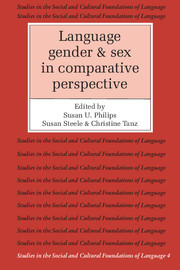Book contents
- Frontmatter
- Contents
- Acknowledgments
- List of contributors
- Introduction: The interaction of social and biological processes in women's and men's speech
- Part I Women's and men's speech in cross-cultural perspective
- Introduction
- 1 The womanly woman: manipulation of stereotypical and nonstereotypical features of Japanese female speech
- 2 The impact of stratification and socialization on men's and women's speech in Western Samoa
- 3 The interaction of variable syntax and discourse structure in women's and men's speech
- 4 A diversity of voices: men's and women's speech in ethnographic perspective
- 5 Women's speech in modern Mexicano
- Part II Gender differences in the language of children
- Part III Sex differences in language and the brain
- References
- Index
3 - The interaction of variable syntax and discourse structure in women's and men's speech
Published online by Cambridge University Press: 05 June 2012
- Frontmatter
- Contents
- Acknowledgments
- List of contributors
- Introduction: The interaction of social and biological processes in women's and men's speech
- Part I Women's and men's speech in cross-cultural perspective
- Introduction
- 1 The womanly woman: manipulation of stereotypical and nonstereotypical features of Japanese female speech
- 2 The impact of stratification and socialization on men's and women's speech in Western Samoa
- 3 The interaction of variable syntax and discourse structure in women's and men's speech
- 4 A diversity of voices: men's and women's speech in ethnographic perspective
- 5 Women's speech in modern Mexicano
- Part II Gender differences in the language of children
- Part III Sex differences in language and the brain
- References
- Index
Summary
In the recent literature on gender differences in language use, the results of empirical research have not always formed a consistent or coherent view (Philips 1980). But one area of relative coherence has been the dialectological research in various European languages. In socialdialectological research on American English, gender differences have been evident for some time (Fischer 1958), and research based on Labovian methods (Labov 1972b) has consistently shown systematic contextual variation in the differences between men's and women's speech. In his study of New York speech (1972b), Labov found men used higher frequencies of so-called stigmatized phonological variants than women. Both men and women used higher frequencies of stigmatized variants in the parts of the sociological questionnaire Labov viewed as involving less self-monitoring of speech, and hence as less formal (e.g., stories about dangerous situations). And because men used more stigmatized variants in all aspects of the sociolinguistic interview, their speech was accordingly characterized as more informal.
In studies outside the United States that closely followed Labov's method, a similar pattern has been found. Thus in Great Britain (Trudgill 1974), Quebec (Sankoff 1974), Panama (Cedergren 1972), and Costa Rica (Berk-Seligson 1978), men use stigmatized phonological variants more frequently than women, and are more like working-class than middle-class speakers in this respect.
Information
- Type
- Chapter
- Information
- Language, Gender, and Sex in Comparative Perspective , pp. 71 - 94Publisher: Cambridge University PressPrint publication year: 1987
Accessibility standard: Unknown
- 8
- Cited by
